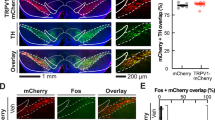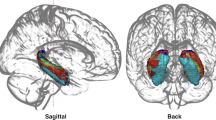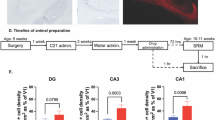Abstract
Long-standing behavioral abnormalities emerge after puberty in rats following neonatal hippocampal lesion, providing a developmental model of abnormal rat behavior that may have predictive validity in identifying compounds effective in treating symptoms of schizophrenia. We sought to test the predictive validity of the neonatal hippocampal lesion model in identifying preventive treatment for first-episode psychosis. We determined the effect of risperidone, recently studied for prevention of first-episode psychosis, on the development of elevated locomotor activity following neonatal hippocampal lesions. Rat pups received hippocampal or sham lesions on postnatal day 7, followed by treatment with risperidone or vehicle from postnatal days 35 to 56. Locomotor activity in response to novelty, amphetamine, and nocturnal locomotion were determined on postnatal day 57. Low-dose risperidone (45 μg/kg) pretreatment prevented elevated locomotor activity in some, but not all, of the behavioral tasks following neonatal hippocampal lesions. In contrast, higher risperidone pretreatment was less effective in preventing elevated locomotor activity following neonatal hippocampal lesions. Because low risperidone dosages were also found to be effective in preventing first-episode psychosis in human studies, these data support the predictive validity of the hippocampal lesion model in identifying medications for prevention of first-episode psychosis. Additionally, these data support the use of low-dose risperidone in psychosis prevention, and suggest the possibility that higher risperidone doses could be less effective in this application.
Similar content being viewed by others
Log in or create a free account to read this content
Gain free access to this article, as well as selected content from this journal and more on nature.com
or
References
Accili D, Fishburn CS, Drago J, Steiner H, Lachowicz JE, Park BH et al (1996). A targeted mutation of the D3 dopamine receptor gene is associated with hyperactivity in mice. Proc Natl Acad Sci USA 93: 1945–1949.
Al-Amin HA, Weinberger DR, Lipska BK (2000). Exaggerated MK-801-induced motor hyperactivity in rats with the neonatal lesion of the ventral hippocampus. Behav Pharmacol 11: 269–278.
Alquicer G, Silva-Gomez AB, Peralta F, Flores G (2004). Neonatal ventral hippocampus lesion alters the dopamine content in the limbic regions in postpubertal rats. Int J Dev Neurosci 22: 103–111.
Arnt J (1995). Differential effects of classical and newer antipsychotics on the hypermotility induced by two dose levels of D-amphetamine. Eur J Pharmacol 283: 55–62.
Bai O, Wei Z, Lu W, Bowen R, Keegan D, Li XM (2002). Protective effects of atypical antipsychotic drugs on PC12 cells after serum withdrawal. J Neurosci Res 69: 278–283.
Broderick PA, Rahni DN, Zhou Y (2003). Acute and subacute effects of risperidone and cocaine on accumbens dopamine and serotonin release using in vivo microvoltammetry on line with open-field behavior. Prog Neuropsychopharmacol Biol Psychiatry 27: 1037–1054.
Bymaster FP, Calligaro DO, Falcone JF, Marsh RD, Moore NA, Tye NC et al (1996). Radioreceptor binding profile of the atypical antipsychotic olanzapine. Neuropsychopharmacology 14: 87–96.
Cabib S, Puglisi-Allegra S (1996). Different effects of repeated stressful experiences on mesocortical and mesolimbic dopamine metabolism. Neuroscience 73: 375–380.
Chambers RA, Moore J, McEvoy JP, Levin ED (1996). Cognitive effects of neonatal hippocampal lesions in a rat model of schizophrenia. Neuropsychopharmacology 15: 587–594.
Chiang YC, Chen PC, Chen JC (2003). D(3) dopamine receptors are down-regulated in amphetamine sensitized rats and their putative antagonists modulate the locomotor sensitization to amphetamine. Brain Res 972: 159–167.
Cornblatt B, Lencz T, Obuchowski M (2002). The schizophrenia prodrome: treatment and high-risk perspectives. Schizophr Res 54: 177–186.
Cornblatt BA (2002). The New York high risk project to the Hillside recognition and prevention (RAP) program. Am J Med Genet 114: 956–966.
Diaz J, Pilon C, Le Foll B, Gros C, Triller A, Schwartz JC et al (2000). Dopamine D3 receptors expressed by all mesencephalic dopamine neurons. J Neurosci 20: 8677–8684.
Dwight MM, Keck PEJ, Stanton SP, Strakowski SM, McElroy SL (1994). Antidepressant activity and mania associated with risperidone treatment of schizoaffective disorder. Lancet 344: 554–555.
Ekman A, Nissbrandt H, Heilig M, Dijkstra D, Eriksson E (1998). Central administration of dopamine D3 receptor antisense to rat: effects on locomotion, dopamine release and [3H]spiperone binding. Naunyn Schmiedebergs Arch Pharmacol 358: 342–350.
Ellinwood EHJ, Sudilovsky A, Nelson LM (1973). Evolving behavior in the clinical and experimental amphetamine (model) psychosis. Am J Psychiatry 130: 1088–1093.
Ellinwood Jr EH (1967). Amphetamine psychosis: I. Description of the individuals and process. J Nerv Ment Dis 144: 273–283.
Flores G, Barbeau D, Quirion R, Srivastava LK (1996a). Decreased binding of dopamine D3 receptors in limbic subregions after neonatal bilateral lesion of rat hippocampus. J Neurosci 16: 2020–2026.
Flores G, Wood GK, Liang JJ, Quirion R, Srivastava LK (1996b). Enhanced amphetamine sensitivity and increased expression of dopamine D2 receptors in postpubertal rats after neonatal excitotoxic lesions of the medial prefrontal cortex. J Neurosci 16: 7366–7375.
Hafner H, Maurer K, Ruhrmann S, Bechdolf A, Klosterkotter J, Wagner M et al (2004). Early detection and secondary prevention of psychosis: facts and visions. Eur Arch Psychiatry Clin Neurosci 254: 117–128.
Henry C, Guegant G, Cador M, Arnauld E, Arsaut J, Le Moal M et al (1995). Prenatal stress in rats facilitates amphetamine-induced sensitization and induces long-lasting changes in dopamine receptors in the nucleus accumbens. Brain Res 685: 179–186.
Hooks MS, Kalivas PW (1995). The role of mesoaccumbens—pallidal circuitry in novelty-induced behavioral activation. Neuroscience 64: 587–597.
Janssen PA, Niemegeers CJ, Awouters F, Schellekens KH, Megens AA, Meert TF (1988). Pharmacology of risperidone (R 64 766), a new antipsychotic with serotonin-S2 and dopamine-D2 antagonistic properties. J Pharmacol Exp Ther 244: 685–693.
Jaskiw GE, Weinberger DR, Crawley JN (1991). Microinjection of apomorphine into the prefrontal cortex of the rat reduces dopamine metabolite concentrations in microdialysate from the caudate nucleus. Biol Psychiatry 29: 703–706.
Javitt DC, Balla A, Burch S, Suckow R, Xie S, Sershen H (2004). Reversal of phencyclidine-induced dopaminergic dysregulation by N-methyl-D-aspartate receptor/glycine-site agonists. Neuropsychopharmacology 29: 300–307.
Jay TM, Witter MP (1991). Distribution of hippocampal CA1 and subicular efferents in the prefrontal cortex of the rat studied by means of anterograde transport of Phaseolus vulgaris-leucoagglutinin. J Comp Neurol 313: 574–586.
Khaing ZZ, Weickert CS, Weinberger DR, Lipska BK (2000). Differential DNA damage in response to the neonatal and adult excitotoxic hippocampal lesion in rats. Eur J Neurosci 12: 4424–4433.
Khan ZU, Gutierrez A, Martin R, Penafiel A, Rivera A, De La Calle A (1998). Differential regional and cellular distribution of dopamine D2-like receptors: an immunocytochemical study of subtype-specific antibodies in rat and human brain. J Comp Neurol 402: 353–371.
Kolachana BS, Saunders RC, Weinberger DR (1995). Augmentation of prefrontal cortical monoaminergic activity inhibits dopamine release in the caudate nucleus: an in vivo neurochemical assessment in the rhesus monkey. Neuroscience 69: 859–868.
Kongsamut S, Roehr JE, Cai J, Hartman HB, Weissensee P, Kerman LL et al (1996). Iloperidone binding to human and rat dopamine and 5-HT receptors. Eur J Pharmacol 317: 417–423.
Laplante F, Stevenson CW, Gratton A, Srivastava LK, Quirion R (2004). Effects of neonatal ventral hippocampal lesion in rats on stress-induced acetylcholine release in the prefrontal cortex. J Neurochem 91: 1473–1482.
Le Moal M, Simon H (1991). Mesocorticolimbic dopaminergic network: functional and regulatory roles. Physiol Rev 71: 155–234.
Leysen JE, Janssen PM, Schotte A, Luyten WH, Megens AA (1993). Interaction of antipsychotic drugs with neurotransmitter receptor sites in vitro and in vivo in relation to pharmacological and clinical effects: role of 5HT2 receptors. Psychopharmacology (Berl) 112: S40–S54.
Lipska BK, Al-Amin HA, Weinberger DR (1998). Excitotoxic lesions of the rat medial prefrontal cortex. Effects on abnormal behaviors associated with neonatal hippocampal damage. Neuropsychopharmacology 19: 451–464.
Lipska BK, Jaskiw GE, Weinberger DR (1993). Postpubertal emergence of hyperresponsiveness to stress and to amphetamine after neonatal excitotoxic hippocampal damage: a potential animal model of schizophrenia. Neuropsychopharmacology 9: 67–75.
Lipska BK, Swerdlow NR, Geyer MA, Jaskiw GE, Braff DL, Weinberger DR (1995). Neonatal excitotoxic hippocampal damage in rats causes post-pubertal changes in prepulse inhibition of startle and its disruption by apomorphine. Psychopharmacology (Berl) 122: 35–43.
Lipska BK, Weinberger DR (1994a). Gonadectomy does not prevent novelty or drug-induced motor hyperresponsiveness in rats with neonatal hippocampal damage. Brain Res Dev Brain Res 78: 253–258.
Lipska BK, Weinberger DR (1994b). Subchronic treatment with haloperidol and clozapine in rats with neonatal excitotoxic hippocampal damage. Neuropsychopharmacology 10: 199–205.
Lipska BK, Weinberger DR (1995). Genetic variation in vulnerability to the behavioral effects of neonatal hippocampal damage in rats. Proc Natl Acad Sci USA 92: 8906–8910.
Lipska BK, Weinberger DR (2000). To model a psychiatric disorder in animals: schizophrenia as a reality test. Neuropsychopharmacology 23: 223–239.
Louilot A, Le Moal M, Simon H (1989). Opposite influences of dopaminergic pathways to the prefrontal cortex or the septum on the dopaminergic transmission in the nucleus accumbens. An in vivo voltammetric study. Neuroscience 29: 45–56.
McGorry PD, Yung AR, Phillips LJ, Yuen HP, Francey S, Cosgrave EM et al (2002). Randomized controlled trial of interventions designed to reduce the risk of progression to first-episode psychosis in a clinical sample with subthreshold symptoms. Arch Gen Psychiatry 59: 921–928.
Meares A (1959). The diagnosis of prepsychotic schizophrenia. Lancet 1: 55–59.
Megens AA, Awouters FH, Schotte A, Meert TF, Dugovic C, Niemegeers CJ et al (1994). Survey on the pharmacodynamics of the new antipsychotic risperidone. Psychopharmacology (Berl) 114: 9–23.
Meltzer HY (1999). The role of serotonin in antipsychotic drug action. Neuropsychopharmacology 21: 106S–115S.
Menalled LB, Dziewczapolski G, Garcia MC, Rubinstein M, Gershanik OS (1999). D3 receptor knockdown through antisense oligonucleotide administration supports its inhibitory role in locomotion. Neuroreport 10: 3131–3136.
Milliken GA, Johnson DE (1992). Analysis of Messy Data. Volume 1: Designed Experiments. Chapman & Hall: London.
Morrison AP, French P, Walford L, Lewis SW, Kilcommons A, Green J et al (2004). Cognitive therapy for the prevention of psychosis in people at ultra-high risk: randomised controlled trial. Br J Psychiatry 185: 291–297.
Myers JE, Thase ME (1903). Risperidone: review of its therapeutic utility in depression. Psychopharmacol Bull 35: 109–129.
Paxinos G, Watson C (1986). The Rat Brain in Stereotaxic Coordinates. Academic Press: San Diego.
Pritchard LM, Logue AD, Hayes S, Welge JA, Xu M, Zhang J et al (2003). 7-OH-DPAT and PD 128907 selectively activate the D3 dopamine receptor in a novel environment. Neuropsychopharmacology 28: 100–107.
Qing H, Xu H, Wei Z, Gibson K, Li XM (2003). The ability of atypical antipsychotic drugs vs. haloperidol to protect PC12 cells against MPP+-induced apoptosis. Eur J Neurosci 17: 1563–1570.
Rebec GV (1998). Real-time assessments of dopamine function during behavior: single-unit recording, iontophoresis, and fast-scan cyclic voltammetry in awake, unrestrained rats. Alcohol Clin Exp Res 22: 32–40.
Rebec GV, Christensen JR, Guerra C, Bardo MT (1997a). Regional and temporal differences in real-time dopamine efflux in the nucleus accumbens during free-choice novelty. Brain Res 776: 61–67.
Rebec GV, Grabner CP, Johnson M, Pierce RC, Bardo MT (1997b). Transient increases in catecholaminergic activity in medial prefrontal cortex and nucleus accumbens shell during novelty. Neuroscience 76: 707–714.
Richelson E, Souder T (2000). Binding of antipsychotic drugs to human brain receptors focus on newer generation compounds. Life Sci 68: 29–39.
Richtand NM, Logue AD, Welge JA, Tubbs LJ, Spitzer RH, Sethuraman G et al (2000). The dopamine D3 receptor antagonist nafadotride inhibits development of locomotor sensitization to amphetamine. Brain Res 867: 239–241.
Richtand NM, Pritchard LM, Coolen LM (2005). Dopamine receptor alternative splicing. In: Schmidt WJ, Reith MEA (eds). Dopamine and Glutamate in Psychiatric Disorders. Humana Press: Totowa, NJ. pp 45–61.
Richtand NM, Welge JA, Levant B, Logue AD, Hayes S, Pritchard LM et al (2003). Altered behavioral response to dopamine D3 receptor agonists 7-OH-DPAT and PD 128907 following repetitive amphetamine administration. Neuropsychopharmacology 28: 1422–1432.
Richtand NM, Woods SC, Berger SP, Strakowski SM (2001). D3 dopamine receptor, behavioral sensitization, and psychosis. Neurosci Biobehav Rev 25: 427–443.
Rueter LE, Ballard ME, Gallagher KB, Basso AM, Curzon P, Kohlhaas KL (2004). Chronic low dose risperidone and clozapine alleviate positive but not negative symptoms in the rat neonatal ventral hippocampal lesion model of schizophrenia. Psychopharmacology (Berl) 176: 312–319.
Sams-Dodd F, Lipska BK, Weinberger DR (1997). Neonatal lesions of the rat ventral hippocampus result in hyperlocomotion and deficits in social behaviour in adulthood. Psychopharmacology (Berl) 132: 303–310.
Schotte A, Janssen PF, Gommeren W, Luyten WH, Van Gompel P, Lesage AS et al (1996). Risperidone compared with new and reference antipsychotic drugs: in vitro and in vivo receptor binding. Psychopharmacology (Berl) 124: 57–73.
Segal DS, Kuczenski R (1994). Behavioral pharmacology of amphetamine. In: Cho AK, Segal DS (eds). Amphetamine and Its Analogues: Pharmacology, Toxicology, and Abuse. Academic Press: Orlando, FL. pp 115–150.
Sesack SR, Pickel VM (1990). In the rat medial nucleus accumbens, hippocampal and catecholaminergic terminals converge on spiny neurons and are in apposition to each other. Brain Res 527: 266–279.
Strange PG (2001). Antipsychotic drugs: importance of dopamine receptors for mechanisms of therapeutic actions and side effects. Pharmacol Rev 53: 119–133.
Sullivan HS (1927). The onset of schizophrenia. Am J Psychiatry 6: 105–134.
Swerdlow NR, Halim N, Hanlon FM, Platten A, Auerbach PP (2001). Lesion size and amphetamine hyperlocomotion after neonatal ventral hippocampal lesions: more is less. Brain Res Bull 55: 71–77.
Swerdlow NR, Lipska BK, Weinberger DR, Braff DL, Jaskiw GE, Geyer MA (1995). Increased sensitivity to the sensorimotor gating-disruptive effects of apomorphine after lesions of medial prefrontal cortex or ventral hippocampus in adult rats. Psychopharmacology (Berl) 122: 27–34.
Tsai G, Coyle JT (2003). Glutamatergic mechanisms in schizophrenia. Annu Rev Pharmacol Toxicol 42: 165–179.
Tsuang MT, Stone WS, Tarbox SI, Faraone SV (2002). Treatment of nonpsychotic relatives of patients with schizophrenia: six case studies. Am J Med Genet 114: 943–948.
Tzschentke TM (2001). Pharmacology and behavioral pharmacology of the mesocortical dopamine system. Prog Neurobiol 63: 241–320.
Ventura R, Cabib S, Puglisi-Allegra S (2002). Genetic susceptibility of mesocortical dopamine to stress determines liability to inhibition of mesoaccumbens dopamine and to behavioral ‘despair’ in a mouse model of depression. Neuroscience 115: 999–1007.
Wallace DR, Mactutus CF, Booze RM (1996). Repeated intravenous cocaine administration: locomotor activity and dopamine D2/D3 receptors. Synapse 23: 152–163.
Wan RQ, Corbett R (1997). Enhancement of postsynaptic sensitivity to dopaminergic agonists induced by neonatal hippocampal lesions. Neuropsychopharmacology 16: 259–268.
Wan RQ, Giovanni A, Kafka SH, Corbett R (1996). Neonatal hippocampal lesions induced hyperresponsiveness to amphetamine: behavioral and in vivo microdialysis studies. Behav Brain Res 78: 211–223.
Waters N, Svensson K, Haadsma-Svensson SR, Smith MW, Carlsson A (1993). The dopamine D3-receptor: a postsynaptic receptor inhibitory on rat locomotor activity. J Neural Transm Gen Sect 94: 11–19.
Woods SW, Breier A, Zipursky RB, Perkins DO, Addington J, Miller TJ et al (2003). Randomized trial of olanzapine versus placebo in the symptomatic acute treatment of the schizophrenic prodrome. Biol Psychiatry 54: 453–464.
Xu M, Koeltzow TE, Santiago GT, Moratalla R, Cooper DC, Hu XT et al (1997). Dopamine D3 receptor mutant mice exhibit increased behavioral sensitivity to concurrent stimulation of D1 and D2 receptors. Neuron 19: 837–848.
Yolken RH, Karlsson H, Yee F, Johnston-Wilson NL, Torrey EF (2000). Endogenous retroviruses and schizophrenia. Brain Res Brain Res Rev 31: 193–199.
Zicha J, Kunes J (1999). Ontogenetic aspects of hypertension development: analysis in the rat. Physiol Rev 79: 1227–1282.
Acknowledgements
This work was supported by the Department of Veterans Affairs Medical Research Service, National Institute of Drug Abuse (DA016778-01), Janssen Pharmaceutica Research Foundation, and Scottish Rite Schizophrenia Fellowship Award (LMP).
Author information
Authors and Affiliations
Corresponding author
Rights and permissions
About this article
Cite this article
Richtand, N., Taylor, B., Welge, J. et al. Risperidone Pretreatment Prevents Elevated Locomotor Activity Following Neonatal Hippocampal Lesions. Neuropsychopharmacol 31, 77–89 (2006). https://doi.org/10.1038/sj.npp.1300791
Received:
Revised:
Accepted:
Published:
Issue date:
DOI: https://doi.org/10.1038/sj.npp.1300791
Keywords
This article is cited by
-
Deficient DNA base-excision repair in the forebrain leads to a sex-specific anxiety-like phenotype in mice
BMC Biology (2022)
-
Developmental timing and critical windows for the treatment of psychiatric disorders
Nature Medicine (2016)
-
Altering the course of schizophrenia: progress and perspectives
Nature Reviews Drug Discovery (2016)
-
Prevention of the Phencyclidine-Induced Impairment in Novel Object Recognition in Female Rats by Co-Administration of Lurasidone or Tandospirone, a 5-HT1A Partial Agonist
Neuropsychopharmacology (2012)
-
Evaluation of animal models of neurobehavioral disorders
Behavioral and Brain Functions (2009)



